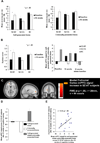Computerized cognitive training restores neural activity within the reality monitoring network in schizophrenia
- PMID: 22365555
- PMCID: PMC3295613
- DOI: 10.1016/j.neuron.2011.12.024
Computerized cognitive training restores neural activity within the reality monitoring network in schizophrenia
Abstract
Schizophrenia patients suffer from severe cognitive deficits, such as impaired reality monitoring. Reality monitoring is the ability to distinguish the source of internal experiences from outside reality. During reality monitoring tasks, schizophrenia patients make errors identifying "I made it up" items, and even during accurate performance, they show abnormally low activation of the medial prefrontal cortex (mPFC), a region that supports self-referential cognition. We administered 80 hr of computerized training of cognitive processes to schizophrenia patients and found improvement in reality monitoring that correlated with increased mPFC activity. In contrast, patients in a computer games control condition did not show any behavioral or neural improvements. Notably, recovery in mPFC activity after training was associated with improved social functioning 6 months later. These findings demonstrate that a serious behavioral deficit in schizophrenia, and its underlying neural dysfunction, can be improved by well-designed computerized cognitive training, resulting in better quality of life.
Copyright © 2012 Elsevier Inc. All rights reserved.
Figures




References
-
- Amodio DM, Frith CD. Meeting of minds: the medial frontal cortex and social cognition. Nat Rev Neurosci. 2006;7:268–277. - PubMed
-
- Baron-Cohen S, Hill J, Wheelwright S. Mind Reading: the interactive guide to emotions. London and New York: University of Cambridge, Kingsley Publishers; 2003.
-
- Benoit RG, Gilbert SJ, Volle E, Burgess PW. When I think about me and simulate you: Medial rostral prefrontal cortex and self-referential processes. Neuroimage. 2010;50:1340–1349. - PubMed
Publication types
MeSH terms
Substances
Grants and funding
LinkOut - more resources
Full Text Sources
Other Literature Sources
Medical

